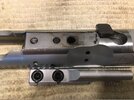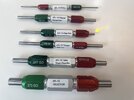Gardner
Member
We went to the range today and one of the rifles we took was an AR-15. I assembled this particular AR in 2012.
We had shot several rifles, and I bring the AR to the table, load a mag, insert mag and pull back on the charging handle to chamber the first round. The CH came to the rear an inch or so and stopped. I saw the ejection port door didn’t open so my first thought was the EP door was jammed. No amount of tugging/jerking could move the BCG more than an inch or so.
I finally decided to separate upper and lower. When I did something fell out of the upper. At first I didn’t recognize it but then it dawned on me…...that’s the gas key!!
As you will see in the photos, both screws sheared flush with the BC.
That’s certainly a first for me. But not really, this same BC sheared the front screw when I first bought it. It took forever for me to figure out where the gas leak was.
What’s odd is that before every range trip (the afternoon before) I remove the bolt and check for lube, whether it’s a bolt gun or semi, run a dry patch down the bore and do an overall look see for safety.
The gas key was attached to the BC when I assembled it and put in its case.
To be clear I did NOT fire a single round today before I found this failure.
Luckily I had a spare BCG in the tool box.
Now I have to find a smith to remove the broken screw stubs, I don’ have to tools for the job.
We had shot several rifles, and I bring the AR to the table, load a mag, insert mag and pull back on the charging handle to chamber the first round. The CH came to the rear an inch or so and stopped. I saw the ejection port door didn’t open so my first thought was the EP door was jammed. No amount of tugging/jerking could move the BCG more than an inch or so.
I finally decided to separate upper and lower. When I did something fell out of the upper. At first I didn’t recognize it but then it dawned on me…...that’s the gas key!!
As you will see in the photos, both screws sheared flush with the BC.
That’s certainly a first for me. But not really, this same BC sheared the front screw when I first bought it. It took forever for me to figure out where the gas leak was.
What’s odd is that before every range trip (the afternoon before) I remove the bolt and check for lube, whether it’s a bolt gun or semi, run a dry patch down the bore and do an overall look see for safety.
The gas key was attached to the BC when I assembled it and put in its case.
To be clear I did NOT fire a single round today before I found this failure.
Luckily I had a spare BCG in the tool box.
Now I have to find a smith to remove the broken screw stubs, I don’ have to tools for the job.








